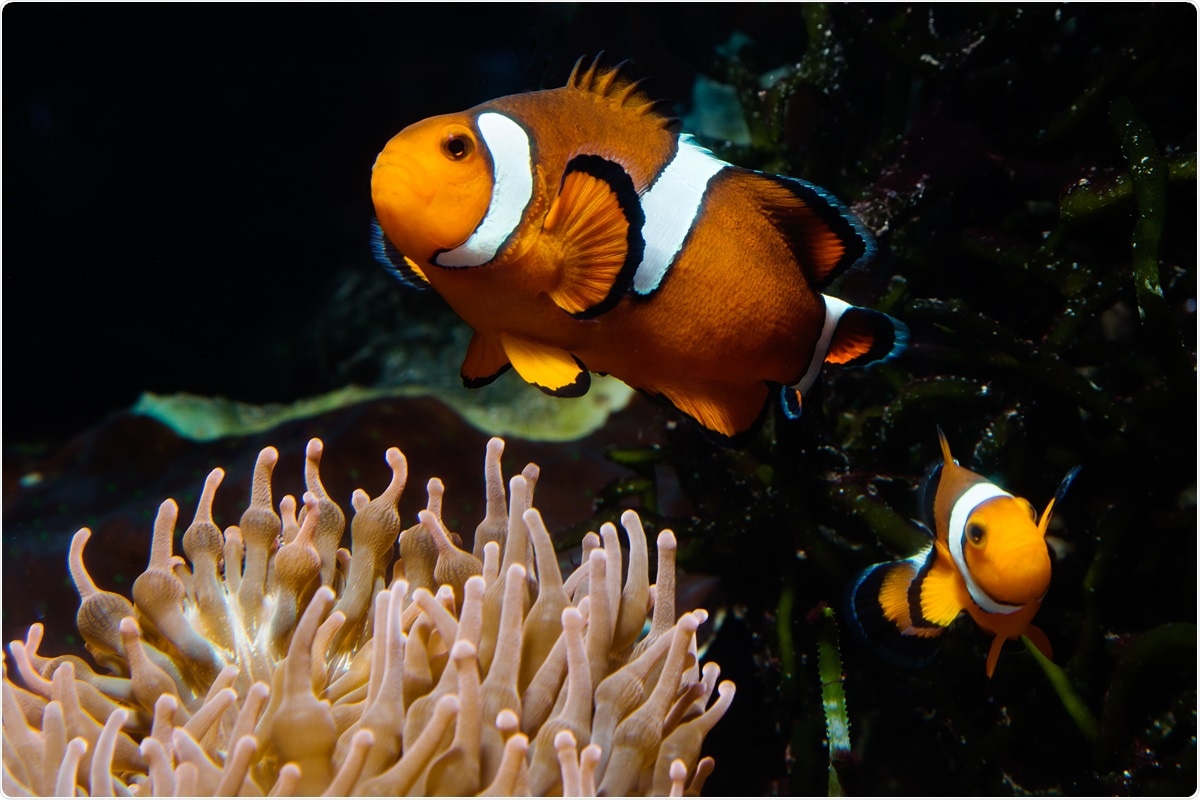A new study shows that two brain-signaling molecules regulate how male anemonefish care for their young ones and react to nest invaders.
Since the brain structure of fish and humans is similar in many ways, the study outcomes provide an understanding of the fundamental nature of parental care, the researchers stated.

Anemonefish spend their lives near their anemones. Females are larger and usually defend the nest; males spend more time tending to the eggs. Image Credit: L. Brian Stauffer.
“One of the benefits of studying fish is that their behaviors are simpler,” stated Ross DeAngelis, a graduate student who performed the study in the laboratory of Justin Rhodes, a professor of psychology at the University of Illinois at Urbana-Champaign. “By exploring these systems, we can understand the broader implications of vertebrate behavior.”
Anemonefish live in pairs on sea anemones underwater. When compared to male anemonefish, females are more aggressive and protect the nest from invaders. The males play a more nurturing role.
Male anemone fish are spectacular fathers. They nourish the eggs by fanning them to provide oxygen and clear debris, and they nip at the eggs to clean them. When a predator is around, they switch their behavior to become aggressive—they try to bite and fight the predators away.”
Justin Rhodes, Professor of Psychology, University of Illinois at Urbana-Champaign
Earlier studies targeted particularly one facet of parental care: either nourishment or defense. The new study aims to gain insights into both aspects together when invaders are present.
The trade-off between defending one’s offspring and caring for them is guided by two hormones. Arginine vasotocin enhances aggression, whereas isotocin encourages egg care. The effects of these hormones on parental behavior in the presence of invaders were obscure to date.
The scientists made use of inhibitory compounds, called antagonists, to inhibit the attachment of arginine vasotocin or isotocin to the corresponding receptors in the brain.
They introduced the compounds into the abdomens of the anemonefish. The antagonists were transported to the brain by the blood from the abdomen.
Blocking arginine vasotocin reduced aggression and increased parental care in male anemone fish. This is an unusual result because they are such good dads – we didn’t think it was possible for them to be even better.”
Ross DeAngelis, Former Graduate Student, University of Illinois at Urbana-Champaign
Inhibition of isotocin was found to have a reverse effect. According to DeAngelis, it enhanced aggression, and the fish spent reduced time nipping and fanning the eggs.
The results are similar to what we see in humans. Oxytocin, which is the human version of isotocin, is known to be important for nurturing. Arginine vasopressin, which is the human version of arginine vasotocin, plays a role in social and affiliative behavior in the slightly different context of mating.”
Justin Rhodes, Professor of Psychology, University of Illinois at Urbana-Champaign
The structures of the two hormones were quite similar and they bind to analogous receptors in the brain. Therefore, scientists cannot be sure that the antagonist for one does not affect the other. Moreover, to date, they have not identified how the hormones particularly modify brain-signaling.
“Individuals across the animal kingdom have to make decisions on how to maximize their fitness, and most of those decisions are based on environmental context. It is interesting to see that the neurochemical pathways can be modulated by the current social context,” concluded Ross DeAngelis.
Rhodes is a member of the Beckman Institute for Advanced Science and Technology at the University of Illinois at Urbana-Champaign. The scientists described the study outcomes in the Hormones and Behavior journal.
Nemo's Dad: Clownfish Fathering (EMMY Winner)
Video Credit: the University of Illinois at Urbana-Champaign.
Source:
Journal reference:
DeAngelis, R., et al. (2020) Nonapeptides mediate trade-offs in parental care strategy. Hormones and Behavior. doi.org/10.1016/j.yhbeh.2020.104717.